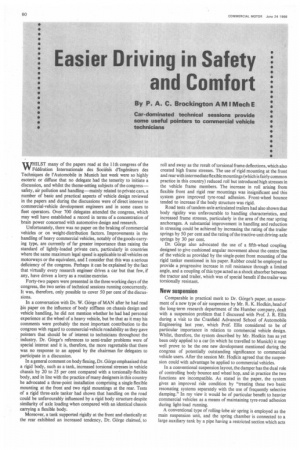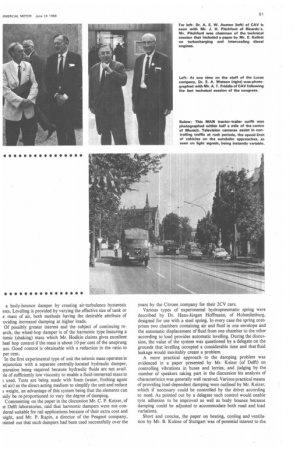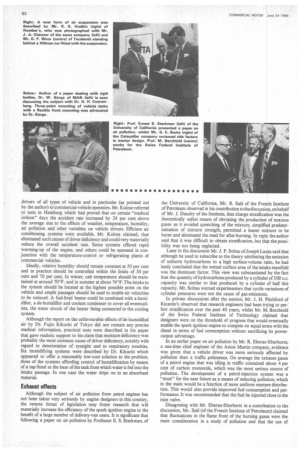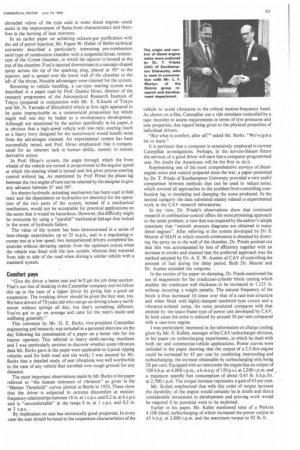Easier Driving in Safety and Comfort
Page 62

Page 63

Page 64

Page 65

If you've noticed an error in this article please click here to report it so we can fix it.
By P. A. C. Brockington A M I Mech E
• Car-dominated technical sessions provide • some useful pointers to commercial vehicle technicians ILST many of the papers read at the 11th congress of the Federation Internationale des SocieteS d'Ingenieurs des Techniques de l'Automobile in Munich last week were so highly esoteric or diffuse that no delegate had the temerity to initiate a discussion, and whilst the theme-setting subjects of the congress— safety, air pollution and handling—mainly related to private cars, a number of basic and practical aspects of vehicle design reviewed in the papers and during the discussions were of direct interest to commercial-vehicle development engineers and in some cases to fleet operators. Over 700 delegates attended the congress, which may well have established a record in terms of a concentration of brain power concerned with automotive design and research.
Unfortunately, there was no paper on the braking of commercial vehicles or on weight-distribution factors. Improvements in the handling of heavy commercial vehicles, notably of the goods-carrying type, are currently of far greater importance than raising the standard of lightly-loaded private cars, particularly in countries where the same maximum legal speed is applicable to all vehicles on motorways or the equivalent, and I consider that this was a serious deficiency of the congress. Perhaps it can be explained by the fact that virtually every research engineer drives a car but that few, if any, have driven a lorry as a routine exercise.
Forty-two papers were presented in the three working days of the congress, the two series of technical sessions running concurrently. It was, therefore, only possible to cover 50 per cent of the discussions.
In a conversation with Dr. W. Gorge of MAN after he had read bis paper on the influence of body stiffness on chassis design and vehicle handling, he did not mention whether he had had personal experience at the wheel of a heavy vehicle, but be that as it may his comments were probably the most important contribution to the congress with regard to commercial-vehicle roadability as they gave pointers that should be of interest to technicians throughout the industry. Dr. Giirge's references to semi-trailer problems were of special interest and it is, therefore, the more regrettable that there was no response to an appeal by the chairman for delegates to participate in a discussion.
In a general comment on body flexing, Dr. Gorge emphasised that a rigid body, such as a tank, increased torsional stresses in vehicle chassis by 20 to 25 per cent compared with a torsionally-flexible body, and in line with the practice of many designers in this country he advocated a three-point installation comprising a single flexible mounting at the front and two rigid mountings at the rear. Tests of a rigid three-axle tanker had shown that handling on the road could be unfavourably influenced by a rigid body structure despite similarity of axle loading when compared with an identical chassis carrying a flexible body.
Moreover, a tank supported rigidly at the front and elastically at the rear exhibited an increased tendency, Dr. Gorge claimed, to roll and sway as the result of torsional frame deflections, which also created high frame stresses. The use of rigid mounting at the front and rear with intermediate flexible mountings (which is fairly common practice in this country) reduced roll but introduced high stresses in the vehicle frame members. The increase in roll arising from flexible front and rigid rear mountings was insignificant and this system gave improved tyre-road adhesion. Front-wheel bounce tended to increase if the body structure was rigid.
Road tests of tandem-axle articulated trailers had also shown that body rigidity was unfavourable to handling characteristics, and increased frame stresses, particularly in the area of the rear spring anchorages. A substantial improvement in handling and reduction in stressing could be achieved by increasing the rating of the trailer springs by 50 per cent and the rating of the tractive-unit driving-axle springs by 30 per cent.
Dr. Gorge also advocated the use of a fifth-wheel coupling designed to give cushioned angular movement about the centre line of the vehicle as provided by the single-point front mounting of the rigid tanker mentioned in his paper. Rubber could be employed to provide a progressive increase in roll resistance through a limited angle, and a coupling of this type acted as a shock absorber between the tractor and trailer, which was of special benefit if the trailer was torsionally resistant.
New suspension
Comparable in practical merit to Dr. Gorge's paper, an assessment of a new type of air suspension by Mr. R. K. Hodkin, head of the long-term research department of the Humber company, dealt with a suspension problem that I discussed with Prof. J. R. Ellis during a visit to the Cranfield Advanced School of Automobile Engineering last year, which Prof. Ellis considered to be of particular importance in relation to commercial vehicle design. Whilst, therefore, the system described by Mr. Hodkin has as yet been only applied to a car (in which he travelled to Munich) it may well prove to be the one new development mentioned during the congress of potentially outstanding significance to commercial vehicle users. After the session Mr. Hodkin agreed that the suspension could with advantage be applied to commercial vehicles.
In a conventional suspension layout, the damper has the dual role of controlling body bounce and wheel hop, and in practice the two functions are incompatible. As stated in the paper, the system gives an improved ride condition by "treating these two basic resonating systems separately with the use of frequently selective damping." In my view it would be of particular benefit to heavier commercial vehicles as a means of maintaining tyre-road adhesion during light-load running.
A conventional type of rolling-lobe air spring is employed as the main suspension unit, and the spring chamber is connected to a large auxiliary tank by a pipe having a restricted section which acts a body-bounce damper by creating air-turbulence hysteresis sses. Levelling is provided by varying the effective size of tank or e mass of air, both methods having the desirable attribute of oviding increased damping at higher loads.
Of possibly greater interest and the subject of continuing rearch, the wheel-hop damper is of the harmonic type featuring a ismic (shaking) mass which Mr. Hodkin claims gives excellent heel hop control if the mass is about 10 per cent of the unsprung ass. Good control is obtainable with a reduction in the ratio to per cent.
In the first experimental type of unit the seismic mass operates in mjunction with a separate centrally-located hydraulic damper, :paration being required because hydraulic fluids are not avail)1e of sufficiently low viscosity to enable a fluid-immersed mass to used. Tests are being made with foam (water, frothing agent Id air) as the direct-acting medium to simplify the unit and reduce s weight, an advantage of this system being that the elements can tsily be re-proportioned to vary the degree of damping.
Commenting on the paper in the discussion Mr. C. P. Keizer, of le Delft laboratories, said that harmonic dampers were not condered suitable for rail applications because of their extra cost and tight, and Mr. P. Rapin, a director of the Peugeot company, ointed out that such dampers had been used successfully over the Various types of experimental hydropneumatic spring were described by Dr. Hans-Jiirgen Hoffmann, of Hohenlimburg, designed for use with a steel spring. In every case the spring comprises two chambers containing air and fluid in one envelope and the automatic displacement of fluid from one chamber to the other according to load provides automatic levelling. During the discussion, the value of the system was questioned by a delegate on the grounds that levelling occupied a considerable time and that fluid leakage would inevitably create a problem.
A more practical approach to the damping problem was evidenced in a paper presented by Mr. Keizer (of Delft) on controlling vibrations in buses and lorries, and judging by the number of speakers taking part in the discussion his analysis of characteristics was generally well received. Various practical means of providing load-dependent damping were outlined by Mr. Keizer, which if necessary could be controlled by the driver according to need. As pointed out by a delegate such control would enable tyre adhesion to be improved as well as body bounce because damping could be adjusted to accommodate both road and load variations.
Short and concise, the paper on heating, cooling and ventilation by Mr. B. Kulose of Stuttgart was of potential interest to the drivers of all types of vehicle and in particular (as pointed out by the author) to commercial-vehicle operatOrs. Mr. Kulose referred to tests in Hamburg which had proved that on certain "medical irrition" days the accident rate increased by 24 per cent above the average due to the effects of weather, temperature, humidity, air pollution and other variables on vehicle drivers. Efficient air conditioning systems were available, Mr. Kulose claimed, that eliminated such causes of driver deficiency and could very materially reduce the overall accident rate. Some systems offered rapid warming-up of the engine, and others could be operated in conjunction with the temperature-control or refrigerating plants of commercial vehicles.
Ideally, relative humidity should remain constant at 50 per cent and in practice should be controlled within the limits of 30 per cent and 70 per cent. In winter, cab temperature should be maintained at around 70°F. and in summer at about 79°F. The intake to the system should be located at the highest possible point on the vehicle and ample passages should be used to enable air velocities to be reduced. A fuel-fired heater could be combined with a humidifier, a de-humidifier and coolant condenser to cover all eventualities, the water circuit of the heater being connected to the cooling system.
Although the report on the unfavourable effects of de-humidified air by Dr. Fujio Kikuchi of Tokyo did not contain any precise medical information, practical tests were described in his paper that gave realistic support to his claim that moisture deficiency was probably the most common cause of driver deficiency, notably with regard to deterioration of eyesight and to respiratory troubles. Six humidifying systems were described by Dr. Kikuchi which appeared to offer a reasonably low-cost solution to the problem, three of the systems affording control of humidification by means of a tap fitted at the base of the tank from which water is fed into the intake passage. In one case the water drips on to an absorbani material.
Exhaust effects
Although the subject of air pollution from petrol engines has not been taken very seriously by engine designers in this country, the remote threat of legislation may foster research that will materially increase the efficiency of the spark-ignition engine to the benefit of a large number of delivery-van users. It is significant that following a paper on air pollution by Professor E. S. Starkman, of
the University of California, Mr. B. Sale of the French Institute of Petroleum observed in his contribution to the discussion, on behalf of Mr. J. Daudry of the Institute, that charge stratification was the theoretically safest means of obviating the production of noxious gases as it avoided quenching of the mixture, simplified predetermination of mixture strength, permitted a leaner mixture to be burnt and eliminated the need for after-burning. In reply the author said that it was difficult to obtain stratification, but that the possibility was not being neglected
Later in the discussion Mr. J. P. Soltau of Joseph Lucas said that although he used to subscribe to the theory attributing the emission of unburnt hydrocarbons to a high surface-volume ratio, he had lately concluded that the wetted surface area of the intake manifold was the dominant factor. This view was substantiated by the fact that the quantity of hydrocarbons produced by a cylinder of 500 c.c. capacity was similar to that produced by a cylinder of half this capacity. Mr. Soltau warned experimenters that cyclic variations of cylinder pressures were not the cause of gas emissions.
In private discussions after the session, Mr. J. H. Pitchford of Ricardo's observed that research engineers had been trying to perfect stratification over the past 40 years, whilst Mr. M. Berchtold of the Swiss Federal Institute of Technology claimed that designers were on the threshold of progress that would eventually enable the spark-ignition engine to compete on equal terms with the diesel in terms of fuel consumption without sacrificing its poweroutput advantage.
In an earlier paper on air pollution by Mr. R. Eberan-Eberhorst, a one-time chief engineer of the Aston Martin company, evidence was given that a vehicle driver was more seriously affected by. pollution than a traffic policeman. On average the exhaust gases of a petrol engine that was idling in traffic contained about 4 per cent of carbon monoxide, which was the most serious source of pollution. The development of a petrol-injection system was a "must" for the near future as a means of reducing pollution, which in the main would be a function of more uniform mixture distribution. This would also provide improved fuel consumption and performance. It was recommended that the fuel be injected close to the inlet valve.
Disagreeing with Mr. Eberan-Eberhorst in a contribution to the discussion, Mr. Sale (of the French Institute of Petroleum) claimed that fluctuations in the flame front of the burning gases were the main consideration in a study of pollution and that the use of shrouded valves of the type used in some diesel engines could assist in the improvement of flame-front characteristics and therefore in the burning of lean mixtures.
In an earlier paper on achieving exhaust-gas purification with the aid of petrol injection, Mr. Eugen W. Huber of Berlin technical university described a particularly interesting pre-combustion swirl type of combustion chamber with a tangential throat, reminiscent of the Comet chamber, in which the injector is located at the top of the chamber. Fuel is injected downstream in a sausage-shaped spray across the tip of the sparking plug, placed at 90° to the injector, and is spread over the lower wall of the chamber to the left of the throat. Notable advantages were claimed for the system.
Reverting to vehicle handling, a car-type steering system was described in a paper read by Prof. Osamu Hirao, director of the research programme of the Aeronautical Research Institute of Tokyo (prepared in conjunction with Mr. E. Kikuchi of Tokyo and Mr. N. Yamada of Mitsubishi) which at first sight appeared to be quite impracticable as a commericial proposition but which might well one day be hailed as a revolutionary development. Although not mentioned by the author specifically in his paper, it is obvious that a high-speed vehicle with low-ratio steering (such as a heavy lorry designed for the motorways) would benefit most from the advantages claimed. An experimental system has been successfully tested, and Prof. Hirao emphasized that it compensated for an inherent lack in human ability, namely to sustain derivative action.
In Prof. Hirao's system, the angle through which the front wheels of the vehicle are turned is proportional to the angular speed at which the steering wheel is turned and this gives precise steering control without lag. As mentioned by Prof. Hirao the phase lag between the two angles of turn can be selected by the designer to give any advance between 00 and 900.
An electro-hydraulic actuating mechanism has been used in field tests and the dependence on hydraulics (or electrics) for the operation of the two parts of the system, instead of a mechanical mechanism, would not be acceptable for practical applications on the score that it would be hazardous. However, this difficulty might be overcome by using a "parallel" mechanical linkage that locked in the event of hydraulic failure.
The value of the system has been demonstrated in a series of lane-change experiments up to 35 m.p.h., and in a negotiating-acorner test at a low speed, two inexperienced drivers completed the exercise without deviating unduly from the optimum course when the vehicle was fitted with the new system, whereas they wavered from side to side of the road when driving a similar vehicle with a standard system.
Comfort pays
"Give the driver a better seat and he'll get the job done quicker. That's our line of thinking in the Caterpillar company and we follow this up in the case of a tipper driver by giving him a good air suspension. The trunking driver should be given the best seat, too. We have drivers of 70 years old who can go on driving a heavy earthmover without springs all day, but that's something different. You've got to go on average and cater for the man's inside and wellbeing generally."
This comment by Mr. G. E. Burks, vice-president Caterpillar engineering and research, was included in a personal interview on the day following his presentation of a paper on a better ride for the tractor operator. This referred to heavy earth-moving machines and I was particularly anxious to discover whether some vibration data Mr. Burks gave in the paper were applicable to typical tipping vehicles used for both road and site work; I was assured by Mr. Burks that a detailed study of seat vibrations was well worthwhile in the case of any vehicle that travelled over rough ground for any distance.
The most important observations made by Mr. Burks in his paper referred to "the human tolerance of vibration" as given in the "Meister Threshold" curves plotted in Berlin in 1935. These show that the driver is subjected to extreme discomfort at motionfrequency relationships between 18 in. at 1 c.o.s. and 0.2 in. at 6 c.p.s. and is "uncomfortable" in the range 8 in. at 1 c.p.s. and 0.2 in. at 3 c.p.s.
By implication no seat has intrinsically good properties. In every case the seat should be tuned to the suspension characteristics of the vehicle to avoid vibrations in the critical motion-frequency band. As shown on a film, Caterpillar use a ride simulator controlled by a tape recorder to assess requirements in terms of tyre pressures and seat properties, due regard being given to the physical properties of individual drivers.
"But what is comfort, after all?" asked Mr. Burks. "We've got a lot to learn."
It is pertinent that a computer is extensively employed in current Caterpillar investigations. Perhaps, in the not-too-distant future the services of a good driver will earn him a computer-programmed seat. No doubt the Americans will be the first to do it.
Representing one of the most comprehensive surveys of dieselengine noise and control prepared since the war, a paper presented by Dr. T. Priede of Southampton University provided a very useful comparison between methods that can be used to reduce noise, which covered all approaches to the problem from controlling combustion lag to insulating and damping the noise produced. In the second category the data submitted mainly related to experimental work in the CAV research laboratories.
In my view, Dr. Priede's observations show that continued research in combustion-control offers the most promising approach to the noise problem, a view that was inspired by the author's simple statement that "smooth pressure diagrams are obtained in many diesel engines". After referring to the system developed by Dr. S. Meurer of MAN in which smooth combustion is obtained by directing the spray on to the wall of the chamber, Dr. Priede pointed out that this was accompanied by loss of efficiency together with an increase in smoke and claimed that the preferred approach was the method adopted by Dr. A. E. W. Austen of CAV of controlling the amount of fuel during the delay period. Both Dr. Meurer and Dr. Austen attended the congress.
In the section of his paper on damping, Dr. Priede mentioned the use of magnesium for the crankcase-cylinder block casting which enables the crankcase wall thickness to be increased to 1.125 in. without incurring a weight penalty. The natural frequency of the block is thus increased 10 times over that of a cast-iron structure and when fitted with highly-damped sandwich-type covers and a vibration-isolated sump, the noise produced compares with that emitted by the space-frame type of power unit developed by C AV. In both cases the noise is reduced by around 50 per cent compared with a cast-iron engine.
I was particularly interested in the information on charge cooling given by Mr. E. Kellett, manager of the CAV turbocharger division, in his paper on turbocharging experiments, in which he dealt with both car and commercial-vehicle applications. Power curves were included in the paper showing that the output of a 2.5-litre engine could be increased by 45 per cent by combining intercooling and turbocharging, the increase obtainable by turbocharging only being 28 per cent. Equipped with an intercooler the engine has an output of 100 b.h.p. at 4,000 r.p.m., a b.m.e.p. of 150 p.s.i. at 2,200 r.p.m. and a minimum specific fuel consumption of about 0.43 lb. b.h.p./hr. at 2,700 r.p.m. The torque increase represents a gain of 43 per cent.
Mr. Kellett emphasized that with this order of output increase the durability of the engine would certainly be in doubt and that a considerable investment in development and proving work would be required if its potential were to be exploited.
Earlier in his paper, Mr. Kellet mentioned tests of a Perkins 4.108 diesel, turbocharging of which increased the power output to 65 b.h.p. at 3,800 r.p.m. and the maximum torque to 92 lb. ft.
























































































































